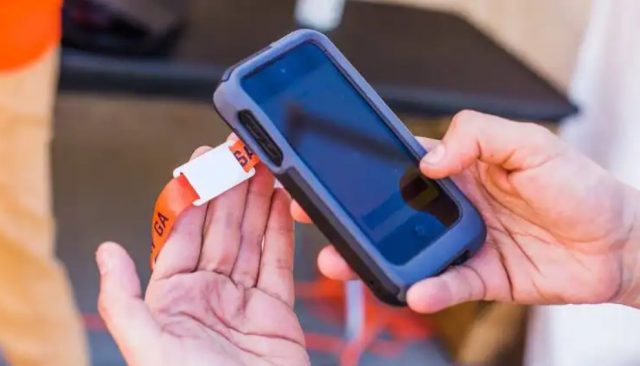RFID wristbands have become a game-changer in the theme park industry, offering numerous advantages for both guests and operators. In this comprehensive guide, we explore various aspects of RFID wristbands for theme parks, including their benefits, challenges, implementation, & future potential.
Understanding RFID Technology
In the context of theme parks, RFID wristbands contain a small chip that stores data such as identification numbers, ticket details, and payment information. When brought close to an RFID reader, the wristband’s chip transmits its data, enabling seamless transactions and interactions throughout the park.
There are two main types of RFID technology used in wristbands:
- Passive RFID. These wristbands do not have their own power source. They are typically more affordable and have a longer lifespan than active RFID wristbands.
- Active RFID. These wristbands have a built-in power source, allowing them to transmit data over greater distances. They are more expensive but offer additional functionality, such as real-time location tracking.
Benefits of RFID Wristbands in Theme Parks
RFID wristbands offer numerous advantages for theme parks, which we will explore in greater detail below:
1. Efficient Entry and Access Control
RFID wristbands significantly speed up entry processes by eliminating the need for manual ticket verification. Guests can simply tap their wristbands against RFID readers at entrance gates, granting them instant access. This reduces wait times & improves overall efficiency.
2. Cashless Payments
One of the standout benefits of RFID wristbands is the ability to make cashless payments throughout the theme park. Wristbands can be linked to guests’ credit/debit cards, allowing them to make secure & convenient purchases.
At a theme park with various dining and shopping options, RFID wristbands could enable guests to pay for food, merchandise, and locker rentals with just a tap. This reduces transaction times, shortens lines, and offers increased security for guests who no longer need to worry about losing their wallets.
3. Personalized Experiences
RFID wristbands can store a wealth of information about each guest, enabling theme parks to create personalized experiences tailored to individual preferences. By analyzing data gathered from wristbands, parks can offer customized ride recommendations, exclusive promotions, or special events based on guests’ interests and past visits.
For example, a family-oriented theme park could use RFID wristbands to offer personalized experiences for children, such as recommending age-appropriate rides or providing interactive games based on their favorite characters. This level of personalization helps create stronger connections between guests and the park, encouraging repeat visits.
4. Enhanced Safety Measures
Safety is a top priority for theme park operators, & RFID wristbands play a key role in enhancing security measures. Parents can link their wristbands to those of their children, enabling them to locate their little ones quickly in case they get separated.
Additionally, wristbands can store medical information, allowing park staff to provide prompt and appropriate assistance in the event of an emergency.This could be especially crucial in situations involving water-related emergencies or allergic reactions to food.
5. Streamlined Ride Reservations
RFID wristbands can be integrated with virtual queuing systems, allowing guests to reserve spots at popular attractions without having to wait in long lines. Visitors can simply tap their wristbands at designated kiosks or use a mobile app to book their ride times.
At a park known for its thrilling roller coasters, RFID wristbands could drastically reduce wait times for popular rides. By eliminating the need to stand in line for hours, guests can enjoy more attractions and have a better overall experience.
Challenges and Considerations
Despite their benefits, RFID wristbands also present certain challenges and considerations for theme parks:
- Privacy Concerns: Address guests’ concerns about the collection and use of personal information by being transparent about data usage and adhering to data protection regulations.
- Infrastructure Investment. Evaluate the costs and potential return on investment associated with implementing RFID wristbands, including RFID readers, point-of-sale systems, and software integration.
- Wristband Durability and Comfort. Ensure guest satisfaction by selecting durable and comfortable materials and designs for wristbands.
- Staff Training. Train staff in the use of RFID wristbands and provide support for guests experiencing technical difficulties.
Implementing RFID Wristbands in Theme Parks
Successfully implementing RFID wristbands in theme parks requires careful planning and execution. Here are some detailed steps and suggestions to consider:
- Evaluate Needs and Goals
Begin by determining the specific objectives you hope to achieve through the use of RFID wristbands. This may include improving entry efficiency, offering personalized experiences, enhancing safety measures, or streamlining ride reservations. Consider surveying guests to identify their pain points and desires, which will help guide your implementation strategy.
- Select the Right Technology
Choose between passive and active RFID technology based on your needs and budget. Passive RFID wristbands are more affordable and have a longer lifespan, making them suitable for applications like access control and cashless payments. Active RFID wristbands, while more expensive, offer additional functionality such as real-time location tracking, which can enhance safety and navigation within the park. (1)
- Design and Procure Wristbands
Collaborate with vendors to design/manufacture wristbands that meet your requirements for durability, comfort, & aesthetics.
Consider factors such as:
- Material.Select materials that are water-resistant, durable, and comfortable for all-day wear, such as silicone or fabric.
- Size and Adjustability. Offer wristbands in various sizes or with adjustable straps to accommodate different wrist sizes.
- Color and Branding. Incorporate your theme park’s colors and logo into the wristband design for a cohesive look and brand recognition.
- Develop Supporting Infrastructure
Install RFID readers and integrate point-of-sale systems to support the various functions of the wristbands.
Consider the following aspects:
- Reader Placement. Install RFID readers at strategic locations, such as entry gates, ride entrances, and payment terminals. Ensure they are easily accessible and visible to guests.
- Network Connectivity. Establish a reliable and secure network connection between RFID readers and your backend system to transmit data efficiently and securely.
- Software Integration. Develop software solutions to manage guest data, process transactions, and support personalized experiences. Integrate these solutions with your existing park management systems.
After completing these steps, you can train staff & pilot the system. Once you’re satisfied with the results, roll it fully to reap the benefits of RFID systems in your theme park. (2)

Speaks from heart, always too passionate and driven by emotions. Spins the words with kindness & sharpness, intriguing your ever-inscrutable minds.




